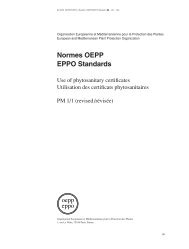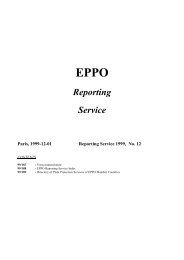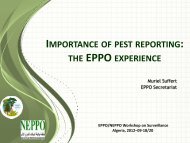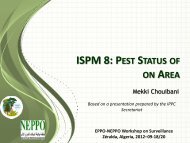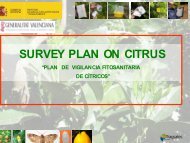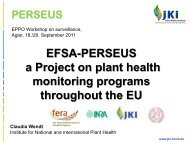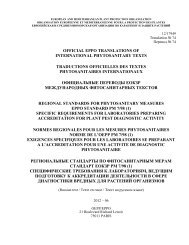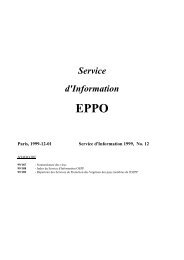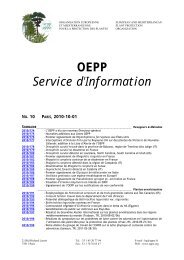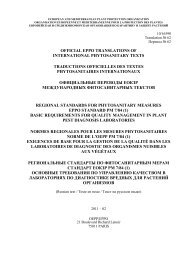EPPO Reporting Service - Lists of EPPO Standards - European and ...
EPPO Reporting Service - Lists of EPPO Standards - European and ...
EPPO Reporting Service - Lists of EPPO Standards - European and ...
Create successful ePaper yourself
Turn your PDF publications into a flip-book with our unique Google optimized e-Paper software.
<strong>EPPO</strong> <strong>Reporting</strong> <strong>Service</strong> – Invasive Plants<br />
these targets will require a significant change in the use <strong>of</strong> l<strong>and</strong> in Europe, which may<br />
cause both direct <strong>and</strong> indirect negative environmental effects, because <strong>of</strong> the changes in<br />
the use <strong>of</strong> semi-natural habitats, or <strong>of</strong> the overall loss <strong>of</strong> forest areas. The potential<br />
increase in invasions that bi<strong>of</strong>uel plants may cause has been scarcely considered in the<br />
<strong>European</strong> context. In fact, bi<strong>of</strong>uel crops are selected for many biological traits which are<br />
common in invasive species: adaptability to poor quality habitats, rapid growth, high seed<br />
production, resistance to pests, etc. The <strong>European</strong> Union has a political m<strong>and</strong>ate to<br />
develop a regional policy on invasive alien species that should cover the bi<strong>of</strong>uels issue. The<br />
key elements to control the introduction <strong>of</strong> bi<strong>of</strong>uel crops could be ensured by either<br />
adapting the existing legislations on plant health, by creating a new sectorial policy on<br />
bi<strong>of</strong>uels, or by integrating these aspects in a comprehensive <strong>European</strong> policy on invasive<br />
alien species. One example <strong>of</strong> a recent sectorial policy that follows similar principles to<br />
those recommended for bi<strong>of</strong>uel, is the aquaculture regulation 708/2007 <strong>of</strong> 11 June 2007.<br />
This legislation has introduced a ban on the introduction <strong>of</strong> any alien species used for<br />
aquaculture, unless a detailed risk assessment has proven that the species is at low risk <strong>of</strong><br />
becoming invasive. It is interesting to notice that this innovative approach for Europe has<br />
been applied to a sector with a significant economic value.<br />
Source: Genovesi P (2010) <strong>European</strong> bi<strong>of</strong>uel policies may increase biological invasions: the<br />
risk <strong>of</strong> inertia. Current Opinion in Environmental Sustainability 3, 1-5.<br />
Additional key words: invasive alien species, bi<strong>of</strong>uel<br />
2011/048 Social sciences perspective: weeds <strong>and</strong> urban space management<br />
The intensive use <strong>of</strong> herbicides in city parks <strong>and</strong> gardens can lead to problems <strong>of</strong> residues<br />
in city waters (above the accepted st<strong>and</strong>ards), as this has been observed for example in<br />
Bretagne in the city <strong>of</strong> Rennes (FR). Tackling this problem implies changing management<br />
techniques for green spaces, but also changing the perception that citizens have <strong>of</strong> weeds.<br />
Menozzi has therefore undertaken a sociological study on the perception <strong>of</strong> weeds in cities,<br />
which is summarized below.<br />
In Rennes (FR), in the framework <strong>of</strong> sustainable management <strong>of</strong> green areas, a project<br />
consisting <strong>of</strong> avoiding the use <strong>of</strong> phytosanitary products both in public <strong>and</strong> private spaces<br />
has been launched in 2 districts. The sociological study then consisted in showing<br />
inhabitants <strong>of</strong> these 2 districts pictures <strong>of</strong> places where spontaneous plants were present<br />
<strong>and</strong> to ask them their opinion on them. Many inhabitants were surprised that the pictures<br />
had been taken in their district <strong>and</strong> did not recognize the places. The enquiries also<br />
highlighted a lack <strong>of</strong> observation <strong>and</strong> recognition <strong>of</strong> plants. Very few <strong>of</strong> the species growing<br />
spontaneously were recognized, <strong>and</strong> plants were generally quoted under generic names<br />
such as “forget-me-not”, or “d<strong>and</strong>elion”. These species were generally designated as<br />
“weeds”, <strong>and</strong> were not considered to be in the right place in urban areas. It appeared that<br />
in the inhabitants’ perception, the city is opposed to the countryside. The presence <strong>of</strong><br />
weeds in the city therefore appears out <strong>of</strong> place to the public, while these species are<br />
tolerated in areas such as riverbeds or along peripheral roads. Pictures showing<br />
spontaneous plants growing along railways were perceived as representing hostile<br />
environments. Interviewees associated areas where herbs grew with the presence <strong>of</strong> rats<br />
or snakes. Other fears linked to the presence <strong>of</strong> these plants included insecurity, <strong>and</strong> the<br />
potential risk <strong>of</strong> these plants to hide road signs. The presence <strong>of</strong> weeds was considered to<br />
make the place dirty <strong>and</strong> neglected. These plants were perceived differently according to<br />
the age <strong>and</strong> the socio-pr<strong>of</strong>essional category <strong>of</strong> the respondents. In public <strong>and</strong> private<br />
areas, popular socio-pr<strong>of</strong>essional classes as well as elders were sensitive to the cleanness<br />
20




